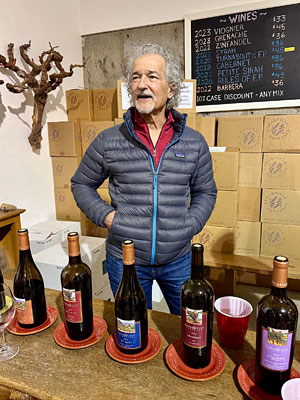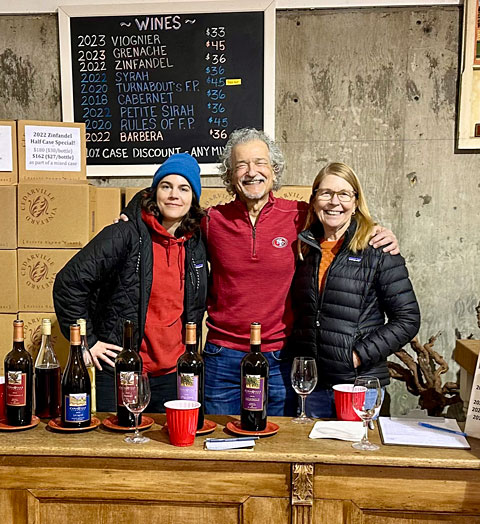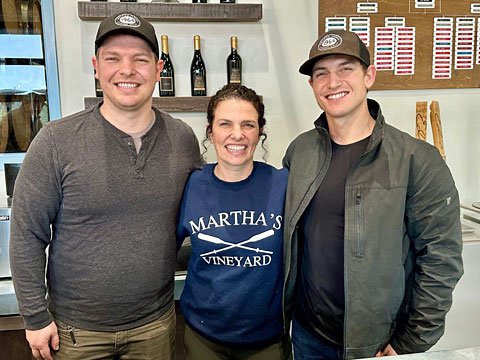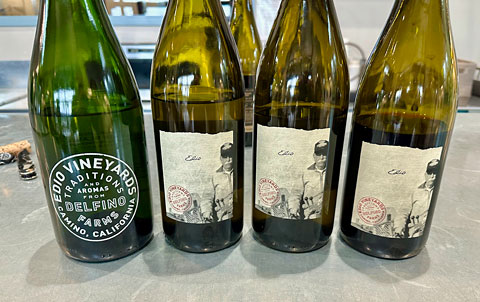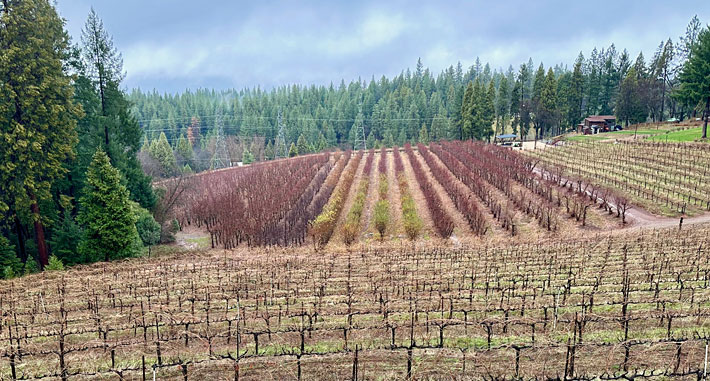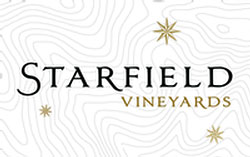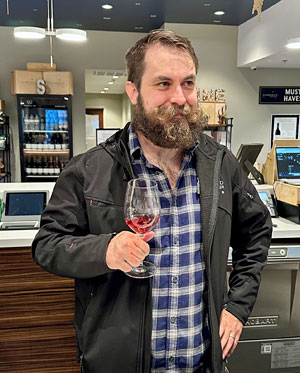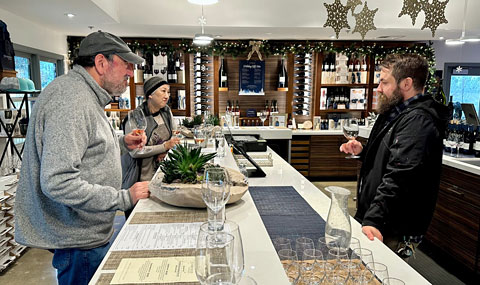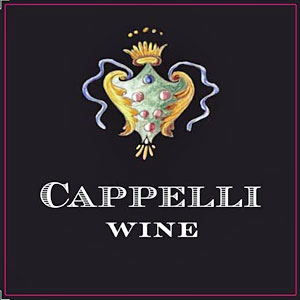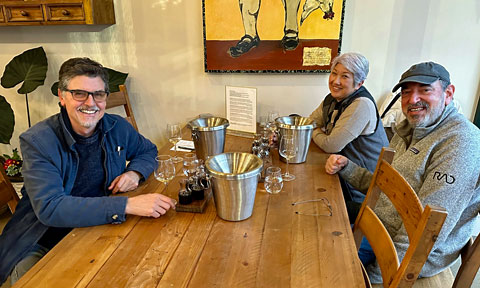Sierra Foothills Visits - January 2025
One of my wine-touring constants for many years has been an annual fall wine trip to the Sierra Foothills but my plans for doing this in November 2024 were derailed at the last minute. Fortunately I was able to reschedule the visits I’d planned to the first Friday of 2025, and my friends Jane and Larry were able to join me. On this occasion all of our visits were in El Dorado County, which was a nice way to shorten the drives between wineries on what’s always a long day-trip from the Bay Area.
There are a few wineries in the Sierra Foothills that I like to visit regularly but I always enjoy trying places I’ve never been to, and I got recommendations for two of those for this trip. I was also able to arrange a tasting with the assistant winemaker at one of the stops – it’s nice to check in on an up-and-coming young winemaker.
As I’ve done before, I met up with Jane and Larry in Berkeley and I drove from there. Although the weather had been pleasant in the days leading up to our wine trip – and it was pleasant again afterwards – it rained for most of the day. It would have been fun to take more of a look at vineyards but that wasn’t much of an option this time so we stuck to winery tasting rooms. Our first stop was a familiar one to all of us, and one that I’ve made on nearly every wine-tasting trip to the Sierra Foothills – Cedarville Vineyard in the Fair Play AVA of southern El Dorado County. But before we tasted their wines, we tasted the first wines from their assistant winemaker.
| Friday
- January 30, 2025 |
Quartz Vein Wines
Jane, Larry, and I were lucky that it was not raining when we arrived at Cedarville Vineyard, and after we parked we headed into the winery where we were welcomed by assistant winemaker Jill Winter. When I’d made an appointment with Cedarville owner/winemaker Jonathan Lachs to visit there, I asked whether Jill might be available to pour her new Quartz Vein wines, which I’d learned about from a late-2023 visit to the winery. Larry and I had met Jill once before, during a spring 2023 visit. We found out shortly before our early 2025 visit that Jill was leaving Cedarville, as she was going to move to Portland and hoped to find a job at a winery in that area.
Jill grew up in nearby Placerville and attended college at UC Santa Cruz. Moving back and looking for a job, she contacted Justin Boeger of Boeger Winery just outside of Placerville – even though she didn’t know much at all about wine at that time – and she worked a harvest and crush for them. That experience got Jill hooked on wine work, and she continued at Boeger for a number of years, learning about wine production and lab work. Along the way she also gained experience by working a harvest in New Zealand and one in Paso Robles. Jill joined the Cedarville winemaking team in summer 2022.
Quartz Vein is a project of Jill and her partner Madison, who’s worked at nearby Miraflores Winery. They were excited about being able to make their own wine at Cedarville. Their winery name is a reference to the Sierra Foothills’ past gold mining days, where a quartz vein in the rock might be a sign of gold deposits. Jill said that the idea of Quartz Vein was to work with quality fruit from organically-farmed Sierra Foothills vineyards and to make the wines with minimal intervention in order to highlight the vineyard and varietal character. The first Quartz Vein wines were made in 2023, and we tasted all three of their wines from that vintage. All three were aged in neutral French oak barrels.
The fruit for the 2023 Viognier came from Cedarville Vineyard. Jill told us that her fruit was picked at about 22 brix, earlier that Cedarville’s own Viognier. This featured aromas of stone fruit and tropical fruit with floral undertones, lighter-bodied with a vibrant texture plus fine acidity, and a clean fresh finish. Our second wine was the 2023 Carbonic Syrah, also sourced from Cedarville Vineyard. The fruit underwent two weeks of carbonic fermentation in a sealed stainless steel tank, which brought it to about 11 brix, and it finished fermentation afterwards. With bright herbal red fruit and a pleasantly smoky note on the nose, a lively mouthfeel, and a touch of tannin on the finish, this is a fun take on Syrah that makes good use of the partial carbonic fermentation.
We finished up with the 2023 Aglianico – this fruit came from a small vineyard near Granite Bay, a lower-elevation site in the Sierra Foothills. This was surprisingly light in color for the variety, and had both red and black fruit along with floral and spice components, medium weight, and moderate tannins. This was a lighter rendition of Aglianico than what you might expect, without the bigger and rougher tannins the variety can often show.
So far, the wines from the initial Quartz Vein vintage are “friends and family” only as it was such small production, only about 130 cases total. Jill told us that they didn’t make any wine in 2024, and that they’d love to continue the label but they’re not yet sure whether they will turn Quartz Vein into a commercial venture. Jill said that she might get a commercial winemaking license after she moves to Oregon, as she mentioned that was an easier process there.
Jane, Larry, and I were all impressed with Jill’s Quartz Vein wines, a very promising first effort for the label. I really enjoyed all three wines – tough to pick a favorite among them. I thought they were quite distinctive, made with a lighter touch, and showing unexpected takes on the Syrah and Aglianico. Jill hopes to learn about working with different grape varieties and cooler-climate viticulture and winemaking in Oregon, and it will be interesting to follow her path there. Hopefully we’ll see more Quartz Vein wines in the future!
Cedarville Vineyard
As we were wrapping up our tasting with assistant winemaker Jill Winter of her own wines, Cedarville owner/winemaker Jonathan Lachs arrived. I’ve been visiting Cedarville for over 20 years and writing about them for nearly as long, so rather than repeat myself too much here, I’ll just provide a brief introduction and guide you to the more detailed information in this past write-up: http://www.grape-nutz.com/kenz/15_sierra.html#cedar
Cedarville was established by co-winemakers Jonathan Lachs and his wife Susan Marks, who sadly passed away in 2020. They’d met while both were earning enology degrees at UC Davis, and though both worked at wineries after graduation, they eventually took other jobs in Silicon Valley. They always envisioned finding a place to plant a vineyard and make their own wine, and after looking in a number of areas, they purchased property at about 2,500-foot elevation in El Dorado’s Fair Play region in 1995 and planted a vineyard there. Jonathan and Susan produced Cedarville’s first commercial vintage in 1998, and they moved there full-time the following year. The winery building – partly built into a hillside for natural cooling – was completed a couple of years later. The name of the winery comes from the long-gone gold-rush era town of Cedarville that was located not far away.
While the winery’s focus has always been on wines from Rhône Valley grape varieties, they also make Zinfandel, Cabernet Sauvignon, and Petite Sirah, a couple of blends, and occasionally other wines. Other than the Petite Sirah, all of the fruit for their regular bottlings comes from their 10-acre estate vineyard, which has been organically-farmed since 2010. Over the past decade Cedarville has cut back on production of its own wine – current annual production is approximately 1,000 cases – while in turn selling more of their estate fruit to a number of well-regarded vintners. With this smaller production requiring a bit less space in the winery, Jonathan has been able to take on a few custom crush clients in recent years, and he said he’s enjoyed working with them there.
The goal of Cedarville’s winemaking has always been to showcase the character of their estate vineyard and its terroir. Jonathan uses a combination of new and older French oak barrels for aging each of the wines. A few years ago the Cedarville wine labels changed a bit from their original design, but they still retain the distinctive artwork by illustrator Jim Meyer that depicts different views of the vineyard.
As we talked with Jonathan, we were joined by the new Susan in his life, Susan Lund. Jonathan refers to her as “Susan Elizabeth” to distinguish her from his late wife “Susan Marie”. Susan Elizabeth has become an integral part of the Cedarville team and shares Jonathan’s warm and easygoing character. Jonathan continues to honor Susan Marie’s memory by making a special “Susan Marie” bottling each year – the sales of this wine help to raise funds for the Pancreatic Cancer Action Network (PanCAN). Jonathan has noted that with sales of these wines, along with donations from friends and family and his own contributions, he’s raised over $80,000 to date. The next “Susan Marie” wine will be a 2024 Rosé.
There are always new things to talk about each time my friends and I visit with Jonathan. He told us about how the vines there, planted in the decomposed granite soils that are distinctive of this region, seem to self-regulate much better as they have gotten older. Jonathan noted that there tend to be fewer clusters per vine, so there’s less work to be done in thinning a heavy crop during the growing season. He also mentioned that fruit clusters tend to be smaller, and with fewer “shoulders” on them.
Another fairly new development that Jonathan talked about with us was the formation of the “El Dorado 8” organization. I’d heard about this group of El Dorado wineries in passing, but our discussion with Jonathan led me to find out more about the group and its member wineries. Though there is already the established El Dorado County Winery Association helping to draw visitors to the county’s wineries – a vital part of the area’s wine business – the El Dorado 8 is a marketing group that’s looking to raise awareness of high-quality El Dorado wines among the broader wine industry and to help distinguish these wines from those of other Sierra Foothills regions. The high elevation, distinctive granitic soils, and other features of El Dorado County vineyards and wine are all part of this. The group is looking more to help promote wines that are in wider distribution rather than ones available only at winery tasting rooms or to wine club members only. They’re spreading the word on many of the region’s best-quality wineries and wines, mostly through social media, and looking to help their member producers push their wines to even higher levels. The El Dorado 8 has only been around for a short time so it should be interesting to follow them as they showcase the wines from these eight (and maybe additional) producers.
Jonathan began pouring most of Cedarville’s current release wines for Jane, Larry, and me, beginning with the 2023 Estate Viognier, their only white wine. This wine was bottled unfined and unfiltered, and with no cold stabilization. With stone fruit aromas along with supporting notes of spice, flowers, and a light touch of oak, this had a medium-rich mouthfeel and bright finish – this wine continues to be a consistent winner from Cedarville. Next was the 2023 Estate Grenache – this marks the first time since the inaugural 1999 Grenache vintage that this wine has been 100% Grenache, as it has usually included a small percentage of Syrah. Bright red fruit and spice with herbal undertones, this had great texture and fine tannins on the long finish – very nice now but a bit more time should really benefit this wine. We followed this with the 2022 Estate Zinfandel. This is also 100% varietal, as has been the case in most recent vintages of the Zin. This showed lots of spice, herb, and earth aromas along with red berries and supporting vanilla/oak notes, with medium texture and youthful tannins on the finish.
|
| Jill, Jonathan, and Susan |
The 2022 Estate Syrah is 100% Syrah, the first time since 1999 that this was not co-fermented with some Viognier (the Viognier vines had just been recently planted back then), as there was not enough Viognier harvested in 2022 due to spring frosts that severely reduced the crop. Displaying dark berry fruit, smoked meat, herbs, black pepper, and a touch of black olive on the nose, this had a fuller mouthfeel and firm tannins – already showing fine complexity but could use a few years of cellaring to develop into something even better. A new wine for Cedarville, the 2022 Barbera was sourced from a nearby Fair Play AVA vineyard. Adding this wine to the lineup in the 2022 vintage helped compensate for the small production that year due to the spring frosts. This had ripe red fruit, spice, and vanilla/oak aromas, balancing a medium-rich texture and bright acidity, with fine tannins on the finish.
The fruit for the 2021 Frostwatch Vineyard “Susan Marie” Merlot came from the Bennett Valley, Sonoma County, vineyard of Jonathan’s longtime friends Brett Raven and Diane Kleinecke. Similarly to the 2022 Barbera, Jonathan looked for fruit to supplement his own in 2021, in this case due to smoke issues from the nearby Caldor fire that year. With herbal black cherry, spice, and an intriguing saline mineral note in the background, this had good structure with moderate tannins – a fine Merlot that deserves a few more years in the cellar. As with the 2022 Barbera, this Merlot was a “one-off”, as Jonathan prefers to focus on the estate vineyard for fruit. Our final wine was the 2018 Estate Cabernet Sauvignon – this wine is 100% varietal, and aged in 50% new and 50% second fill French oak barrels. Jonathan told us that their next Cabernet release will be from the 2022 vintage. This wine showed a black currant and darker berry fruit profile plus dried herb, spice, and vanilla/oak notes with plenty of structure for additional aging.
In addition to the wines we tasted on this visit, Cedarville also makes Petite Sirah, as well as two red blends – “Turnabout’s Fair Play” and “Rules of Fair Play”. I asked Jonathan whether he has anything new planned in the future and he said he’s looking forward to continuing his small-scale hands-on winemaking and making minor adjustments to his processes.
Cedarville has done a lot to help raise the quality level of wine from El Dorado County – and particularly the Fair Play area – over the years, and Jonathan is looking forward to continuing to be involved with the El Dorado 8 and their focus on the region’s highest-quality wines. Over the years, Cedarville’s wines have shown remarkable consistency, and while vintage variations are certainly evident, the winemaking always allows the vineyard character to show through. As usual, all of the wines we tasted were very good, with my favorite wines on this occasion being the 2023 Grenache and 2022 Syrah – perhaps the best of these two in some time – and I liked the 2023 Viognier, 2022 Barbera, and 2021 Merlot nearly as much. I always give Cedarville my highest recommendation whenever friends ask me where to visit in El Dorado County.
With the chilly and rainy weather, Jane, Larry, and I knew that a picnic lunch would not be an option on this day, so we decided to stop for lunch at Bones Roadhouse in Pleasant Valley, located about midway between Cedarville and our next winery stop. Jane and I had stopped there for lunch on a previous wine trip and enjoyed the food there. The vibe both inside and out is of a classic roadhouse, and as was the case during our earlier visit there, it was clear that this was a popular spot for locals to gather, which I always feel is a good sign. The menu is mainly wings, burgers, hot dogs, and a variety of hot and cold sandwiches, along with a decent selection of beers. Larry and I both had burgers, and Jane ordered a fried chicken sandwich. Service was quick, and my burger was tasty if not especially memorable, but we all thought the fries were some of the best we’ve had! There are not a lot of options for lunch in this part of El Dorado County, and Bones Roadhouse has proven to be a reliable choice.
From there we continued north along winding Snows Road, which has several tight hairpin turns as it climbs from the Cosumnes River up a steep slope toward Camino, at about 3,000-foot elevation. A number of wineries and vineyards are located in this area, among the highest winegrape-growing regions in California.
Edio Vineyards at Delfino Farms
The first afternoon stop of the day for Jane, Larry, and me was at Edio Vineyards at Delfino Farms, located near the town of Camino at the eastern end of El Dorado County’s Apple Hill area. None of us had been to Edio or tried their wines before but we’re always interested in checking out wineries that are new to us so we were looking forward to the visit. As implied by the name, Edio Vineyards is just a part of Delfino Farms, a multi-generation business run by the Delfino family. Though the winery tasting room was not scheduled to re-open until the next day following a holiday break, Peter and Derek Delfino graciously arranged to meet us there. We had no trouble finding it, and made a quick dash through the rain from the car to the tasting room entrance, where Peter and Derek welcomed us inside.
|
| l to r: siblings Peter Delfino, Christine Noonan, and Derek Delfino |
Peter is the Edio winemaker while his brother Derek is the vineyard manager, and they introduced us to their sister Christine, who is the general manager and runs the hospitality end of the family business. They’re part of the third generation of the Delfino family to farm their Camino property. Their great-grandparents Frank and Secondina Delfino had emigrated from Italy in the early 1920s and settled near St. Helena in Napa Valley. Their son Edio grew up there and met his future wife Joan while he was attending college at Cal Poly San Luis Obispo, and following that, he worked in the Sonoma County Agricultural Department. In the early 1960s Edio took the position of El Dorado County Agricultural Commissioner, and he and Joan purchased the property near Camino and moved there in 1962, eventually planting over 2,000 apple trees there.
In addition to farming the property and his Agricultural Commissioner job, Edio was one of the co-founders of the Apple Hill Growers Association in 1964 – the area is now famed for its fresh apples, pies, ciders, and other apple products, as well as for pumpkin patches and Christmas tree farms. In the early 1970s, Edio and Joan let their seven children name the family business – they came up with “Kids Inc.” and that was the business name for many years. The bakery part of their business that was started around that time – now called Joan’s Apple Bakery – is still an integral part of Delfino Farms. In addition to apples, the family has grown pumpkins and gourds, blackberries, and other crops as well as raising some livestock. In 2002, the next generation of the family took over, with Chris and Robyn Delfino purchasing the farm and running the business.
Though Edio had planted some Cabernet Sauvignon vines on the property in the 1970s, wine didn’t become a focus of the family business for awhile. Chris and Robyn’s kids Peter, Derek, and Christine, who all followed in Edio’s footsteps and attended Cal Poly San Luis Obispo, returned to the family farm after working in the wine industry, mainly in the Central Coast area. Peter has mentioned Steve Dooley of Stephen Ross Wine Cellars as a particular mentor, while Derek worked at Law Estate and at Ridge’s Sonoma County vineyards, and Christine worked at Denner Wines and Chamisal Vineyards.
Peter and Derek told us that their family has been longtime friends with the people at pioneering El Dorado wineries Boeger and Lava Cap, and that they and Christine felt there was lots of potential for winegrapes at their property. Peter and Derek said that Christine was the one who felt most strongly that this was the future for their family’s farm and helped convince them of this direction. In 2017 the three established Edio Vineyards along with their parents and their brother Ben. The first vintage of Edio Vineyards wine came in 2018, and after initially making their wines at a couple of other local wineries they opened their own winery and tasting room in 2020. The Delfino Farms business, including the vineyards and winery, continue to be run entirely by the family. They honor Edio and Joan, who founded the family farm in Camino, with the names of the winery and the bakery.
The Edio tasting room offers a beautiful view across the vineyards, and the lower part of the tasting counter is made from old Delfino Farms wooden fruit crates. The vineyard site adjacent to the winery is about 22 acres at around 3,000-foot elevation. They also have a nearby 20-acre site at around 2,400-foot elevation plus a lower-elevation 10-acre site, as well as managing other vineyards in the area. Other than the older Cab vines, the estate vineyards were planted from 2010-2014 and are farmed using organic practices, and they typically dry-farm the vines though they may occasionally irrigate if needed during a heat spike. Peter and Derek credit the late El Dorado vineyard manager Ron Mansfield with steering them toward planting Rhône grape varieties, and they noted that they still work with Ron’s son Chuck.
In terms of winemaking, they use minimal intervention, and they aim for higher acidity in their wines than many other producers in the region, so fruit is generally picked on the earlier side. Some white wines are made entirely in stainless steel tanks while others are barrel-fermented and aged, some all in neutral French oak barrels and some with a small percentage of new oak depending on the wine. For red wines, they’re all fermented with whole (not crushed) berries and sometimes with a percentage of whole clusters. Most reds are aged in some new French oak – the ones we tasted ranged from no new oak to 33% new. They typically spend 10-12 months in barrel, with some, such as the “Frank’s Rhône Blend” we tasted, getting longer aging. All of the wines are bottled unfined and unfiltered.
Peter and Derek had set up a very nice seated tasting of six of their current Edio wines for us to taste, and we started with their 2023 Sparkling Chenin Blanc. The fruit came from nearby Camino Alto Vineyard and the wine was aged for nearly a year in neutral French oak before undergoing a Charmat-style sparkling process in tank. This had bright citrus and toast aromas plus floral hints, with plenty of acidity and fine bubbles. Next up was the 2023 Estate Albariño, which was fermented and aged entirely in stainless steel. Peter and Derek mentioned that planting Albariño at their vineyard had been recommended by their friends at Boeger Winery. With upfront citrus and green apple aromas plus herbal undertones and a saline mineral note, this displayed a medium-light texture with vibrant acidity and a fresh finish – this might develop a bit more with short-term aging but it’s delicious right now. We tasted one more white wine, the 2023 “Robyn’s Blend,” with 60% Viognier, 35% Roussanne, and 5% Picpoul sourced from three El Dorado vineyards. This was barrel-fermented in 15% new French oak, and underwent bâtonnage (lees stirring in barrel) during fermentation. This featured stone fruit aromas with hints of orangepeel and spice, medium weight on the palate, and a long flavorful finish.
|
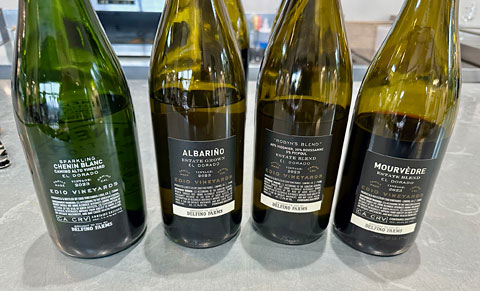 |
Our first red wine was the 2023 Estate Grenache. The fruit was entirely destemmed before fermentation in bins, pressed early to help manage tannins and reduce astringency, and aged entirely in neutral French oak. This had intense red fruit, spice, and floral aromatics, a medium-light texture, and good structure with fine tannins. We followed that with the 2023 Mourvèdre, sourced from both estate fruit and organically-farmed David Girard Vineyard. This was bin-fermented with about 15% whole clusters and aged in 32% new French oak. Plum and black cherry on the nose along with iron and red meat and a peppery note, with medium body and moderate tannins – very intriguing now but worth cellaring to allow further development. Our final wine of the tasting was the 2022 “Frank’s Blend” – 54% estate Mourvèdre and 46% Syrah from David Girard Vineyard, aged for 22 months in 33% new French oak. Peter and Derek said that this blend usually includes Grenache but they didn’t have enough of that variety in 2022 due to the spring frosts in that vintage. Displaying a darker fruit profile along with spice and vanilla/oak notes, this had a bigger texture with plenty of structure and a firm tannic finish.
In addition to the wines we tasted, Edio also produces Picpoul from Camino Alto Vineyard, “Oliver’s” Chardonnay sourced from the Talley Oliver’s Vineyard in Edna Valley, San Luis Obispo County, and “Canavese Cab” Cabernet Sauvignon from Miller Vineyard in Alameda County. Annual production is about 4,000 cases and they’re currently selling everything direct to consumer. Peter noted that they’re working on adding a list of ingredients to their wine labels, to help consumers know more about their minimal-intervention winemaking.
In addition to the Edio wines, Delfino Farms also makes Henrietta Stich Cider, with two hard apple ciders and a blackberry cider, with a new co-fermented peach cider in the works. We tried the Heritage Hard Cider at the end of our tasting, and it was quite nice. And as mentioned above, there’s Joan’s Apple Bakery, with several kinds of apple pies, plus apple crisps, apple cheesecake, blackberry pie, and more. Delfino Farms also hosts outdoor live concerts in the vineyard during the summer months – their “Folk on the Farm” series features country, bluegrass, and folk music.
Our visit to Edio Vineyards at Delfino Farms was really enjoyable. Peter and Derek were great hosts – very animated and talkative, and obviously enthusiastic about what they’re doing, and it was fun to meet Christine if only briefly. The Sierra Foothills have been known for bigger, riper wines, and while this remains true in some places, the higher-elevation vineyards of the Camino area (and some other parts of El Dorado County) show that excellent wines can be produced with more modest ripeness and alcohol. All of the Edio white wines we tasted were no more than 13.3% alcohol and the reds were 14.2% or lower, and the wines showed a lighter, elegant touch throughout. All of the wines we tasted with Peter and Derek were very good – favorites included the 2023 Albariño, 2023 Grenache, and 2023 Mourvèdre, and I liked the 2023 “Robyn’s Blend quite a bit too. Edio Vineyards at Delfino Farms was a real discovery for me, and our visit with Peter, Derek, and Christine made it clear that family and farming are foremost for them. A stop here should definitely be on your itinerary when touring El Dorado County wineries.
Starfield Vineyards & Winery
Our next afternoon winery visit was a fairly short drive away, at Starfield Vineyards & Winery just northeast of Placerville. As had been the case for most of the day, we made a quick dash through the rain from the car to the tasting room, where we were greeted by winemaker Rob Sinton. Rob and his father Tom are the proprietors of Starfield.
The Sinton family has a long history in the wine business – Tom’s grandfather partnered with Louis Martini to produce sacramental wine during Prohibition. Tom grew up on his family’s ranch in the Paso Robles area, where they grew alfalfa and sugar beets and raised cattle. When he was a teenager he spent a summer with his family in France which kindled his love of wine. In 1972, Tom planted grapevines on the family ranch – this became Shell Creek Vineyard, still a noted vineyard site. Tom earned an enology degree from UC Davis and managed Shell Creek until he sold the vineyard in 1990. Though he subsequently spent a number of years in other business ventures, he never gave up on the idea of planting another vineyard and starting a winery. Rob wasn’t too interested in wine when he was young, but he also attended UC Davis and after taking a wine course and dabbling in home winemaking he ultimately switched his major to viticulture and enology.
The Starfield label was established in 2011 with a small amount of wine that Tom and Rob made in Napa Valley at a custom crush facility. They wanted to establish their own vineyard, winery, and tasting room, and knew that doing that in Napa would be too expensive for them. While they continued to make wine in Napa for a few more vintages, they searched up and down the West Coast for a place where they could plant their own vineyard. In 2012 they purchased their property in El Dorado County at an elevation of 2,400 feet – the higher elevation and sloping hillsides were a particular attraction to them.
Starfield began planting grapevines on their property in 2013, and they currently have about 30 acres of vines with 16 grape varieties in 24 vineyard blocks, with mostly Rhône and Italian varieties as they felt those would do well at their site. The vineyard features a number of different soil types and slope aspects. The vines are farmed sustainably with Fish Friendly Farming practices, and the Sintons have created the extensive Gardens at Starfield which run through the vineyard site and include paths that lead out from the tasting room. The first harvest from the estate vineyard came in 2016. Starfield typically sells about 30-50 tons of their estate fruit to other vintners though Rob told us that they didn’t sell as much last year. Tom continues to do much of the vineyard management work while Rob has taken the lead in making the wines since 2020.
Though Tom and Rob would like to build their own winemaking facility in the future, they’ve been making their wine at the Element 79 winery in the Fair Play region in recent years. They produce a wide variety of wines at Starfield, both single-varietal and blends. Almost all of the Starfield wines are made with estate-grown fruit except for their Chardonnay, Pinot Noir, and Cabernet Sauvignon. For white wines, fruit is whole-cluster pressed and typically barrel-fermented in neutral oak in a temperature-controlled space. They block malolactic fermentation for most whites, and the wines stay on their lees for an extended time in barrel. Blends for white wines are done early in the year following harvest and bottled in the spring. Red wines are fermented in stainless steel tanks, sometimes with a percentage of whole clusters, and blends are usually done the following spring. Reds are typically aged for 12-18 months in a combination of new and older barrels – mainly French oak along with a smaller number of Hungarian and American oak barrels for some wines.
After Jane, Larry, and I had introduced ourselves to Rob, he asked us whether we’d prefer to taste while standing at their indoor tasting counter or have a seated tasting on their heated covered patio. We checked outside but even with overhead heaters it was still a bit chilly so we opted to taste indoors. Since none of us had any particular tasting agenda in mind, Rob had us choose what we wanted to taste from the large number of wines on the Starfield tasting menu. Rob did ask if we felt like starting off with a sparkling wine, and we thought that sounded good, so he poured us the 2021 Sparkling Brut Rosé. Made entirely from Grenache and picked for rosé at about 19 brix, this was made by the traditional Méthode Champenoise, with 18 months in bottle prior to release. This featured upfront citrus and stone fruit aromas with floral undertones and fine bubbles.
We continued with four white wines, beginning with 2023 Vermentino. Unlike most of the Starfield whites, this was fermented in a stainless steel tank and then aged for 8 months mostly neutral French oak barrels. With citrus, stone fruit, and herb aromas, this had a medium-light texture, bright acidity, and a fresh finish. Next was the 2023 Viognier, fermented and aged in 25% new French oak, with bâtonnage (lees-stirring) and full malolactic fermentation. Displaying tropical fruit and stone fruit on the nose plus spice and floral undertones, this had medium weight and slightly creamy texture on the palate with a clean finish.
The 2023 Marsanne, blended with 8% Roussanne, was another tank-fermented white, aged in 8% new French oak, and with no malolactic fermentation. Rob told us that during visits with Tom to the Rhône Valley, he found that he preferred the Marsannes from there that did not go through malolactic fermentation. Upfront stone fruit aromas with hints of citrus and herbs, this had medium texture and a pleasant finish. Our final white wine was the 2023 “Hope Rising” blend – 43% Marsanne, 43% Roussanne, and 14% Viognier, aged in about 90% neutral French oak. This featured brighter stone fruit and citrus on the nose, a touch of spice, and a good balance of a medium-rich mouthfeel and fine acidity, with a long finish.
Moving on to red wines, we started with three lighter ones. The 2022 Grenache was made from 100% Grenache and aged in about 15% new French oak. This had a ripe red fruit profile along with plenty of spice, moderate tannins and a fresh finish. We followed that with the 2022 Cinsault, which was blended with 3% Counoise and 2% Grenache, and aged in 25% new French oak. Showing even more spice on the nose than the previous wine, this also displayed ripe red fruit and earth plus a touch of vanilla/oak, with fine tannins. Another lighter red was the 2022 Counoise, blended with 5% Cinsaut and aged in a little under 20% new French oak. This featured upfront floral aromas with strawberry and herb notes, medium body with fine tannins and a lively and flavorful fresh finish.
We wanted to try a couple of the bigger red wines so we next tasted the 2020 Aglianico, blended with 3% Grenache and aged in about 50% new French oak barrels. With darker ripe berry fruit plus earth and spice aromas, it had plenty of structure and fairly grippy tannins. The 2022 Tempranillo was also blended with 3% Grenache and aged mostly in French oak along with a little Hungarian and American oak. This had a more earthy aromatic profile with dark berry fruit, spice, dried herbs, and hints of smoked meat and vanilla/oak, with medium-full body and good structure.
I was curious about the winery’s Starfield Light line of wines, which are de-alcoholized to 8%. We decided to taste the 2022 Starfield Light “Smith Flat Red Blend” – a blend of eight varieties led by 41% Mourvèdre and including 5% Muscat. This had subtle plum and blueberry notes, with a fairly light mouthfeel and finish. Rob thought it would be interesting to compare that wine with the same wine that had not gone through the de-alcoholizing process. This 2022 “Smith Flat Red Blend” was actually not on the tasting room wine list and it was a fascinating comparison. This had similar but bolder aromatics, with earth and herb components joining the fruit notes, a bigger structure on the palate and longer finish. Rob noted that they’re just starting to experiment with the Starfield Light line and he feels that there’s a niche for them in the wine market.
Other wines that we didn’t taste with Rob include Fiano, Chardonnay, Rosé, Pinot Noir, Barbera, Mourvèdre, Cabernet Sauvignon, several red blends, Muscat, and a Starfield Light white blend and Rosé. In addition, they produce two sweet Vermouths (with more to come). There are a lot of different bottlings, and Rob noted that this has become part of Starfield’s appeal, since they have something for nearly everyone. He said that he’s been particularly happy that the Mourvèdre and Cinsaut have been doing very well, and that those varieties really show the “Sierra Spice” that many El Dorado vintners feel is a hallmark of wines from the region. Starfield currently makes around 3,000 to 5,000 cases annually depending on the vintage, and almost all of their wines are sold direct to consumer.
I asked Rob if there’s anything new coming up, and he said that he and Tom co-fermented more different varieties in 2024 than they’ve done before – for example 8% Aglianico co-fermented with Mourvèdre, 5% Roussanne with Syrah, and a co-fermented field blend of Rhône varieties for their Rosé. Rob also said that Starfield is introducing a new label design and that the tasting room will be offering new options that include chocolate and cheese pairings. And with ever-present wildfire threats, they’re continuing to upgrade the fire protection of their buildings and other property.
Jane, Larry, and I had a fun time talking and tasting with Rob at Starfield. He was quite an engaging host, and we enjoyed the wines. While we didn’t take advantage of the tasting room patio on this cool and rainy day, it looked like a beautiful spot to enjoy a tasting in nicer weather. The wines displayed a good balance between ripeness and restraint – neither too bold nor too lean – that delivered plenty of flavor while allowing the varietal character to show through more clearly than from a number of other producers. My favorites included the 2023 Vermentino, 2023 “Hope Rising,” 2022 Counoise, and 2022 Tempranillo. As Rob pointed out, with Starfield’s extensive lineup of wines, visitors to the tasting room are almost sure to find something they like.
Cappelli Wine
The last wine visit of our day in El Dorado wine country was at Cappelli Wine in Placerville – in my most recent visit to the area it proved a convenient location for the final stop since it’s very close to the US50 freeway for the drive back to the Bay Area. The Cappelli tasting room is located right along the town’s charming main street, and I’d arranged to meet owner/winemaker Marco Cappelli there. I’d visited with Marco twice in 2023, once with Larry and once with Jane and another friend, and we were all happy to return there. To avoid too much repetition in this write-up, I’ll just provide some introductory notes here, and you can find more detailed information in an earlier write-up: http://www.grape-nutz.com/kenz/23_sierra.html#cappelli
Marco grew up in Carmel, California. Unlike many Italian immigrants, his parents were teetotalers so he didn’t have the family history of making some wine at home that seems such a common story among Italian-American vintners. Marco attended UC Davis and after taking a wine class there he decided to change his focus to enology. He worked a harvest at Louis Martini winery during his college years and earned his degree from Davis in 1984. He followed that by spending over a year in Europe, learning about winemaking in Italy and France. After returning to California he was fortunate to be introduced to André Tchelistcheff, who hired Marco for a position at then-new Swanson Vineyards in Napa Valley, where Marco stayed as winemaker for 17 years.
Marco decided to move to El Dorado County in 2004, and he’s been making wine for many local labels in the years since, mostly at Miraflores Winery in the Pleasant Valley area. Marco also owned the noted Herbert Vineyard in the Fair Play region for a number of years but sold it and moved to Placerville with his wife Belinda after the 2021 Caldor Fire. The couple had already started working toward launching their new winery and opening their Placerville tasting room before then, and the tasting room opened in spring 2023.
Marco has an interesting – and perhaps unique in California – concept for how the winery and tasting room are run. Marco produces the wines at the Miraflores facility, and he brings 15-gallon kegs of his wines to the tasting room for filling bottles there. He uses Vinolok glass closures so that customers can bring both the bottles and closures back to the tasting room to be cleaned and re-used, getting a discount on a new bottle of wine when they do. The bottles, labels, and closures are all identical, and a small sticker is added to identify the wine in the each bottle. Marco typically will bottle some wines in the morning before the tasting room opens to have them ready for customers but he’s also able to fill bottles on the spot from the keg taps.
Marco’s goal is to produce terroir-driven wines sourced from local vineyards at affordable prices for everyday drinking, much as the wines he’d found during a year-long stay in Italy with Belinda and their children a few years ago. He’s noted that the wine shouldn’t be the most expensive thing on the dining table, and his new system is one way to keep costs down so the wine is more affordable – and re-using the bottles and closures is good for the environment as well. Marco also helps to make the wines affordable by working with some that he buys as bulk wine, rather than making everything from scratch, which tends to be more expensive.
It had been a short drive from our previous winery stop to Placerville, and we were lucky to find a parking spot along the street directly across from the Cappelli tasting room. We were also lucky that the rain had stopped by that time late in the afternoon, so it wasn’t necessary to run from the car to the entrance. Marco was already there, and as was the case on my previous visit, the place was busy. We asked Marco how business has been and he was very happy with how things have been going. He’s been selling enough wine there – due to the unique concept I’m sure that nearly all of his customers are local – and he told us that a good percentage of customers bring back empty bottles and glass closures to be re-used, and we saw some do just that while we were there.
There are typically six dry wines available for tasting, and since my most recent visit Marco has added a second sweet wine to the tasting lineup options as well as a sparkler. The line-up changes as the wines – which are all produced in fairly small lots – are sold out and replaced by other ones. After having a seat with Marco at one of the tables inside the bright airy space, we were brought small containers of each wine to pour into our wineglasses so we could taste at our own pace. Marco mentioned to us that all of his wines are unfined and unfiltered.
We began with the 2023 “Bianco” – a blend of 80% Riesling from Wilson Vineyard in Clarksburg and 20% Chardonnay from the Sierra Foothills. The Riesling was tank-fermented while the Chardonnay was fermented in barrel. This displayed bright stone fruit aromas plus subtle floral and herbal notes, medium-light weight on the palate, and a clean finish. Next was a NV Chardonnay blend from the 2022 and 2023 vintages, with 50% barrel-fermented Chardonnay from a vineyard near Murphys in Calaveras County and 50% from Clarksburg that was fermented in a stainless steel tank. With apple and pear on the nose, this was a very pleasant lighter-style Chardonnay with good acidity and a lively finish.
Moving on to red wines, we had the 2023 Pinot Noir from the same vineyard site in Calaveras County as the Chardonnay, aged entirely in older French oak. Featuring ripe black cherry aromas with notes of flowers, orangepeel, and earth, this was medium-bodied with milder tannins. We followed that with a 2023 Charbono from Cooper Vineyard in Amador County’s Shenandoah Valley. This had plum and darker berry fruit along with hints of spice and smoked meat, a bigger texture and good structure. The NV “BX” Bordeaux-Inspired Blend consists of 2023 Merlot from Arrastra Vineyard near Placerville and 2019 Cabernet Sauvignon and Cabernet Franc from Calaveras County. With black currant, plum, dried herbs, and a touch of pepper plus undertones of spice and oak, this had medium-full body and a lively mouthfeel and finish. Our final dry red was a 2023 Old-Vine Zinfandel, with about 80% of the fruit coming from 100-year old vines in Lodi and around 20% from 45 year-old vines in the Sierra Foothills, plus a small amount of Foothills Syrah. Marco told us that his bigger red wines have been particularly popular with customers. Showing ripe and upfront boysenberry and darker fruit plus spice on the nose, this had a moderately rich texture and finish.
We finished up our tasting at Cappelli with two sweet wines, a style that Marco is especially noted for. Marco brought out these wines in a couple of beautiful old glass decanters to pour for us. The NV Fortified Muscat was made from about 50% each Orange Muscat and Muscat Canelli, fortified about 25% of the way through fermentation. Marco intends to let this wine continue to age and intentionally oxidize in barrel. Displaying stone fruit, orangepeel, and spice aromas, fairly sweet with a rich texture and long finish, this was starting to develop the nutty character that further aging in barrel will bring out in time, though it’s already quite intriguing and distinctive.
Our final wine was the NV Mission Angelica, with fruit sourced from Rinaldi (formerly Eschen) Vineyard in the Fiddletown region – the Mission vines there may be over 150 years old. Marco told us that this is about 85%-90% Mission fruit with the rest consisting of various table grape varieties that were interplanted in the vineyard. Angelica, typically made from Mission grapes, was probably California’s earliest signature wine style though few vintners produce it these days. Marco ages his Angelica wines for quite awhile – this one, made from multiple vintages, has had an average of eight years in barrel. The wine is intentionally allowed to oxidize in barrel, giving it a character not unlike a Tawny Port. This wine did indeed resemble a Tawny Port, with pecan and caramel aromas plus stone fruit and figs, with enough acidity to balance its sweet, rich character, and with a very long finish.
Marco is one of the friendliest vintners I’ve met and it’s always a fun time visiting him. Given the unusual concept of the Cappelli wine program, we were very glad to hear from Marco that the wines and tasting room have been successful. As I’ve mentioned before, the dry wines are not intended to “knock your socks off” but you’ll have a tough time finding everyday California wines that deliver more for the money. Each of the dry wines we tasted were $14-$18 per bottle (the sweet wines are more), and customers receive a discount for returning an empty bottle and glass closure to be reused. My favorite dry wines on this visit were the NV Chardonnay, 2023 Charbono, and particularly the NV “BX Bordeaux-Inspired blend, and both the NV Fortified Muscat and NV Mission Angelica were outstanding. A visit to Cappelli remains just about the only way to taste and buy their wines, and in the short time that the tasting room has been open it’s become a “must” stop for me in the Placerville area.
Jane, Larry, and I said goodbye to Marco, and before taking off from Placerville we admired the holiday lights and other decorations that were still along the main street there, including a large Christmas tree. We decided to have dinner in Davis, as I’d done with Jane and another friend on my previous Sierra Foothills daytrip, to cut down the lengthy drive home to the Bay Area into two more manageable parts. Once again, we chose dinner at the Sudwerk brewpub. Jane ordered a fried chicken sandwich to compare with the one she’d had at lunch, while Larry and I both ordered the Pilsner Beer Brat with house sauerkraut, hefeweizen onions, whole-grain mustard on a brioche bun, which came with fries. There's an extensive choice of Sudwerk beer on tap, and we each chose a lighter brew. The food was tasty if not especially outstanding, but it hit the spot.
This was yet another fun wine day-trip to the Sierra Foothills. We combined visits to two past favorites – Cedarville and Cappelli – with two others to wineries that none of us had any experience with before – Edio and Starfield. And we also had time to taste with a promising young vintner, Jill Winter, who’s on her way from El Dorado County to Oregon but I suspect will be back one day, and hopefully she’ll continue her Quartz Vein wines.
Cedarville, Edio, and Starfield are all part of the recently-formed El Dorado 8 group that’s helping to promote the fine wines from a number of the region’s producers, and each of these three wineries focuses on fruit from their own estate vineyard. In a region where no one or two grape varieties predominate, spreading the word about the distinctive terroir of higher-elevation vineyards planted on granitic and volcanic soils and surrounded by tall conifers seems like a promising direction. Though Cedarville, Edio, and Starfield each craft their wines in somewhat different styles, they each showcase the distinctive El Dorado character. And while the Cappelli wines have a broader range of vineyard sources, the way in which they’re bottled and sold to customers makes them special, a unique experience. I’d gladly make a return visit to any of these four wineries, and I probably will do so. As always, thanks to everyone that my friends and I visited for being so generous with their time and their wine!
|



